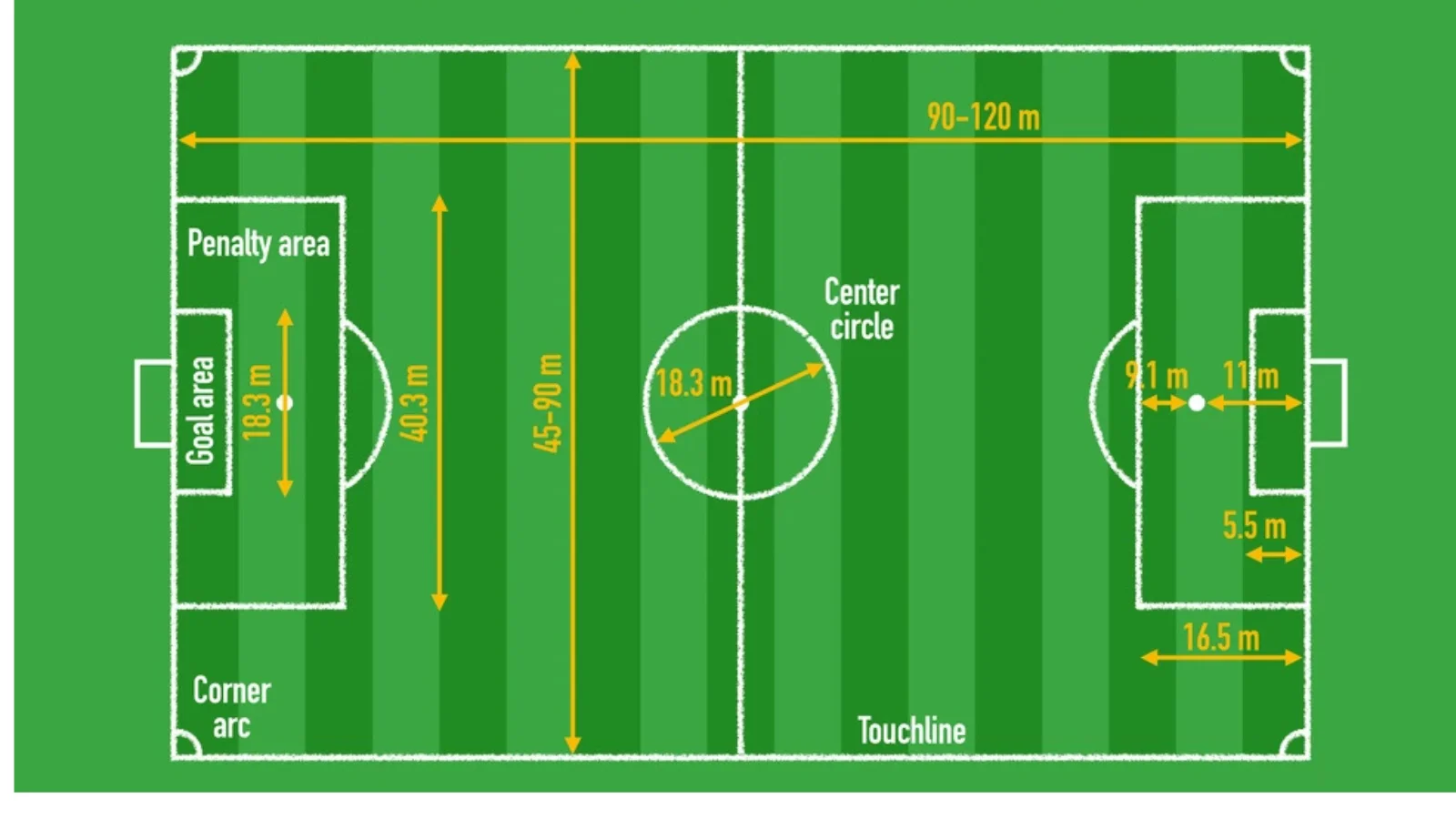Understanding the dimensions of a soccer field (also known as a football pitch) is essential for players, coaches, and fans alike. These measurements, regulated by the Laws of the Game, set the stage for the beautiful game. In this article, we’ll delve deep into the specifics of soccer field sizes, their variations across different levels of play, and the implications these dimensions have on gameplay.
Standard Dimensions of a Soccer Field
Overall Size
According to FIFA (Fédération Internationale de Football Association), the dimensions of a soccer field can vary significantly. Here’s a breakdown of the overall size:
- Length:
- Minimum: 100 yards (90 meters)
- Maximum: 130 yards (120 meters)
- Width:
- Minimum: 50 yards (45 meters)
- Maximum: 100 yards (90 meters)
- Average Field Dimensions:
- Length: 110 yards (100 meters)
- Width: 70 yards (64 meters)
These dimensions can vary based on the level of play, but FIFA’s guidelines ensure that all professional matches adhere to these standards.
Markings on the Field
A soccer field isn’t just a vast green area; it’s meticulously marked to regulate play. Here are some key markings and their significance:
- Goal Area:
- Dimensions: 6 yards (5.5 meters) from each goal post, extending 6 yards (5.5 meters) into the field.
- Penalty Area:
- Dimensions: 18 yards (16.5 meters) from each penalty mark, extending 18 yards (16.5 meters) into the field.
- Center Circle:
- Diameter: 10 yards (9 meters). This circle is crucial during kick-off and for restarting play after a goal.
- Corner Arc:
- A quarter-circle with a radius of 1 yard (1 meter), this marks the area where the ball is placed for corner kicks.
These markings play a vital role in ensuring fair play and adherence to the laws governing the sport.
Variations in Field Size
Dimensions for Different Levels of Play
Soccer fields can vary dramatically based on the level at which the game is played. Here’s a closer look:
Professional Level
At the professional level, such as in leagues like the Premier League or Major League Soccer (MLS), the field dimensions typically conform to FIFA regulations, maintaining consistency in gameplay across different venues. Most professional pitches are around 110 yards (100 meters) in length and 70 yards (64 meters) in width, offering ample space for players to showcase their skills.
Youth and Amateur Levels
The dimensions for youth leagues and amateur matches vary to accommodate the developmental needs of younger players.
- U8 (Under 8):
- Field Size: 60 x 40 yards (55 x 37 meters)
- U10 (Under 10):
- Field Size: 70 x 50 yards (64 x 46 meters)
- U12 (Under 12):
- Field Size: 80 x 55 yards (73 x 50 meters)
These adjustments help younger players develop their skills in an appropriately scaled environment.
International Regulations
FIFA’s regulations ensure that soccer fields used in international competitions meet strict guidelines. A standard international soccer field must adhere to the following:
- Length: 100 to 110 meters
- Width: 64 to 75 meters
These dimensions help standardize the experience for players and fans alike, ensuring that international matches maintain a consistent playing surface.
Impact of Field Size on Gameplay
How Dimensions Affect Team Strategy
The dimensions of a soccer field can significantly influence gameplay strategies. A larger field allows for more expansive play and encourages a more fluid passing game, while smaller fields often lead to more compact and aggressive tactics.
- Larger Fields:
- Encourage a possession-based style of play.
- Allow for greater player movement and creativity.
- Often lead to more goal-scoring opportunities as players find space.
- Smaller Fields:
- Favor defensive strategies.
- Require quicker decision-making and tighter passing.
- Often result in fewer goals due to congested play areas.
Importance of Grass Type and Field Condition
The playing surface of a soccer field is also crucial. The type of grass used can affect ball movement, player traction, and overall gameplay.
- Natural Grass:
- Offers good traction and ball control but requires regular maintenance.
- Artificial Turf:
- Provides consistent playing conditions and requires less maintenance, making it a popular choice for many amateur fields.
The field’s condition, including its softness or hardness, can affect player safety and performance. Well-maintained fields contribute to a fair and enjoyable game.
Notable Soccer Fields and Their Dimensions
Iconic Stadiums
Several stadiums around the world are renowned for their unique characteristics and dimensions. Here’s a list of some famous soccer fields and their dimensions:
| Stadium | Location | Length (m) | Width (m) |
| Wembley Stadium | London, England | 105 | 68 |
| Camp Nou | Barcelona, Spain | 105 | 68 |
| Old Trafford | Manchester, England | 106 | 69 |
| Allianz Arena | Munich, Germany | 105 | 68 |
| Maracanã Stadium | Rio de Janeiro, Brazil | 110 | 75 |
These stadiums not only provide a home for their respective teams but also serve as iconic venues for international matches.
Historical Changes in Field Sizes
Over the years, soccer field dimensions have undergone changes. In the early 20th century, field sizes varied widely, leading to confusion and inconsistent gameplay. However, as the sport evolved, FIFA established standardized dimensions to ensure fairness and safety. This evolution reflects soccer’s growth into a globally recognized sport, where uniformity in field markings and sizes became essential.
Conclusion
Understanding the dimensions of a soccer field is crucial for anyone involved in the sport, from players to coaches and fans. The standard sizes set by FIFA ensure that matches are played under fair conditions, allowing athletes to showcase their skills effectively. Additionally, recognizing how field sizes impact gameplay strategies can enhance appreciation for the sport.
Additional Resources
For those interested in diving deeper into the subject of soccer field dimensions and regulations, consider checking out the following resources:
- FIFA Official Regulations on Field Dimensions
- Books on soccer tactics and strategies
- Local league guidelines for youth soccer field sizes
By understanding the dimensions and characteristics of a soccer field, you’ll gain a greater appreciation for the game and its intricacies. Whether you’re a player or a passionate fan, knowing the specifics can enrich your experience of this beautiful game.

Ethan Richards is a dedicated sports writer who excels in delivering timely and accurate sports news. His meticulous research and clear, concise writing make his articles both informative and enjoyable. Ethan’s commitment to quality journalism sets him apart in the industry.











